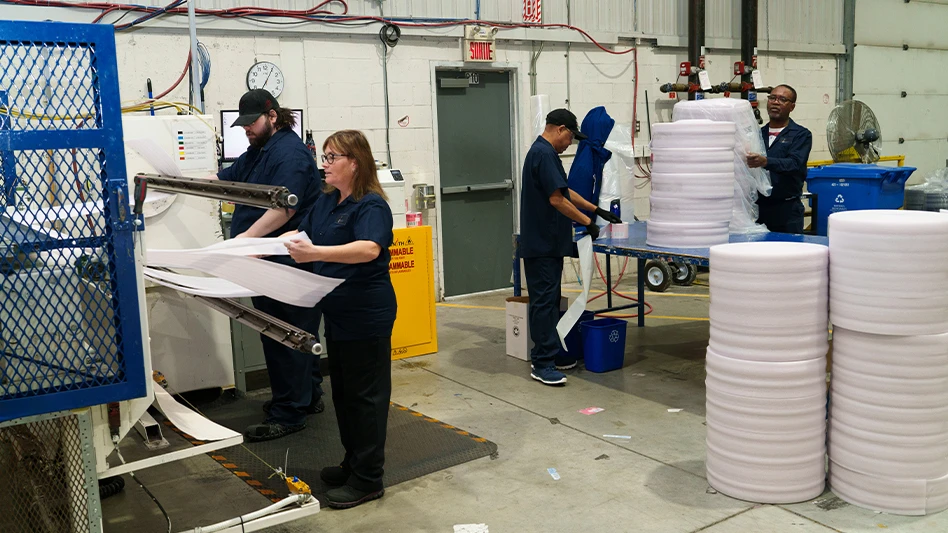The Tire Product Stewardship Summit April 20 at the TIA World Tire Expo covered guidelines, strategies and techniques for product stewardship programs and the barriers and weaknesses that could limit stewardship initiatives.
Speakers at the summit included Anne Evans of EER Limited and Tyre Recovery Association Responsible Recyclers Scheme, Julie L. Rhodes of the Product Stewardship Institute and Paul Hyatt, president of Superior Tire and vice President of TIA.
Evans addressed the evolution of the voluntary, free market approach to waste tire recovery in the United Kingdom. She said the Tyre Industry Council (TIC) was formed in 1989 to address tire industry issues and is made up of the U.K. Department of Trade and Industry, the National Tire Distributors Association, the Retread Manufacturers Association, the British Rubber Manufacturers Association and the Imported Tire Manufacturers Association.
The European Union has banned whole tires from landfills in 2003 and shredder tires will be banned beginning in 2006. In light of these bans, the government asked the TIC to recommend the best way to handle the 65 million waste tires generated yearly, Evans said, adding that the industry shunned product stewardship at the time.
Evans said that tire transporters and collectors in the U.K. saw the need for the use of best practices and accreditation, which lead to the Responsible Recyclers Scheme, established in 2000 by Waste Tyre Solutions, Tyre Collection Services, REG and Environmental Disposal.
Under the Responsible Recyclers Scheme members are audited by an independent firm that validates the tonnage of tires transported and processed, Evans said, with each member company paying 25 pence per metric ton of tires collected and processed.
Processors and recyclers were invited to join the Responsible Recyclers Scheme in 2002, she added. Then in 2004, the Tyre Recovery Association was established in 2004 to manage the Responsible Recycler Scheme. Its membership is made up of collectors, recyclers, processors and TDF consumers.
Julie Rhodes of Product Stewardship Institute (PSI), Boston, said the organization’s mission is to assist “state and local government agencies in establishing cooperative agreements with industry and developing other initiatives that reduce the health and environmental impacts from consumer products.”
Rhodes said that shared responsibility is the key to product stewardship.
Consumers pay fees ranging from 25 cents to $5 per tire in 35 states for tire recovery, with the retailers collecting the fees and arranging for proper management, Rhodes said. States help with funding, education, abatement, market development and research, while manufacturers provide education.
PSI has partnered with the California Integrated Waste Management Board to work on the issue of scrap tires. The state generates 33.5 million waste tires annually, Rhodes said, charging a tire disposal fee of $1 per tire.
Collectors, haulers, storage facilities and tire processors must be registered with the state. According to Rhodes, 16,000 tire generators are registered with the state currently and tire manifesting is required to provide tracking and oversight.
California’s approach includes reducing the number of waste tires generated by making longer-lasting tires and increasing recycled content in new tires.
PSI designated three tiers of priorities for scrap tires in California. The top tier consisted of waste tire markets, tire-derived fuel and recycled asphalt concrete, Rhodes said. The second tier included shredded tire markets, crumb rubber markets, collection and transportation, waste tire generation and tire reuse, retread and remold. The third tier included recreation markets, sustainable financing, landfill disposal and recycled content in new tires, she said.
The organization then identified markets within each of the tiers and the challenges associated with each of them. However, consensus has not been reached on priorities, objectives and goals in the state, Rhodes said, adding that additional stakeholder meetings, work groups and other activities will work toward the needed consensus.
Paul Hyatt outlined product stewardship efforts in Canada’s provinces and went into detail about the efforts Ontario is undertaking.
The Ontario program is currently under development m with tire dealers currently operating a self-regulated scrap tire management program that captures more than 90 percent of the scrap tires generated, or 11 million PTEs, he said.
Under the Ministry of Environment, a funding organization was created to develop and administer a scrap tire management program called Ontario Tire Stewardship (OTS).
The proposed program calls for a $4-per-tire fee for consumer tires and a $6-per-tire-fee for commercial tires that is to be submitted to the retailer, Hyatt said. Consumers would not be obligated or legislated to pay the fee, but retailers would be obligated to submit supporting documentation and fees monthly.
The Ontario program would designate the retailer as the principal scrap tire generator and would require a manifest system from generation to recycled product, with fixed fees allocated to haulers and subsidies allocated to processors, he said.
Hyatt said, “The complexion of the Ontario Tire Stewardship Board is flawed by design” and not representative of the “Working Industry,” but is influenced by brand owners, first importers and big box retailers.
He added that the law would call for confidential audit records to be submitted to the board, causing a potential conflict of interest. In addition, the proposed plan ignores the Minister’s directions in the area of product stewardship, Hyatt says. “Stewardship was clearly defined as brand owner, first importer.”
Hyatt also argued that scrap tires are not a problem in Ontario, as the private sector currently handles more than 90 percent of scrap tire recovery and because illegal dumping is rare and most illegal piles have been remediated.
He charges that the Ontario Tire Stewardship program will disrupt current well-functioning markets for scrap tires, creating a huge administrative burden in the process.
“The proposed plan as submitted by the OTS Board is a well intentioned, complex but flawed solution in a desperate search of a problem,” Hyatt said.
He offered two suggestions for a true product stewardship approach to tires: One, regulate and resister the haulers, continue Ministry enforcement, allow free enterprise to continue to function and support retailers, haulers and consumers. Two, assign stewardship to brand owners and first importers, level the playing field for all retailers, charge a modest fee of $1 to retailers to cover R&D and stockpile remediation and facilitate tracking and auditing.
The TIA World Tire Expo was April 20-22 at the Kentucky International Convention Center in Louisville.
Latest from Recycling Today
- Nucor names new president
- DOE rare earths funding is open to recyclers
- Design for Recycling Resolution introduced
- PetStar PET recycling plant expands
- Iron Bull addresses scrap handling needs with custom hoppers
- REgroup, CP Group to build advanced MRF in Nova Scotia
- Oregon county expands options for hard-to-recycling items
- Flexible plastic packaging initiative launches in Canada





